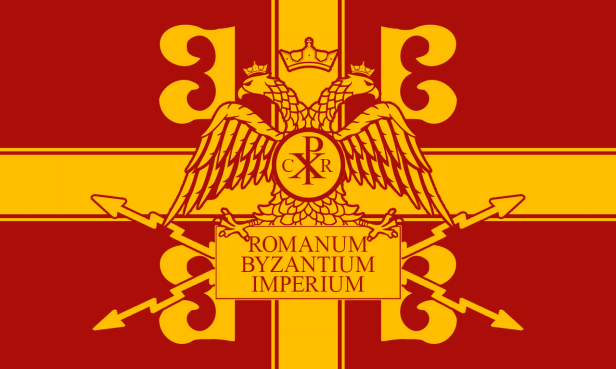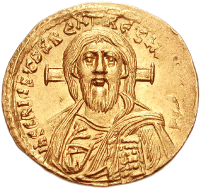| National Factbook |
| Flag: |

|
| Nation Name: |
Byzantium |
| Leader Name: |
Constantine Dragases |
| Currency: |

Denar |
| National Animal: |

Aquila |
| History: |
The Byzantine Empire was a vast and powerful civilization with origins that can be traced to 330 A.D., when the Roman emperor Constantine I dedicated a “New Rome” on the site of the ancient Greek colony of Byzantium. Though the western half of the Roman Empire crumbled and fell in 476 A.D., the eastern half survived for 1,000 more years, spawning a rich tradition of art, literature and learning and serving as a military buffer between Europe and Asia. The Byzantine Empire finally fell in 1453, after an Ottoman army stormed Constantinople during the reign of Constantine XI
In 330 A.D., Roman Emperor Constantine I chose Byzantium as the site of a “New Rome” with an eponymous capital city, Constantinople. Five years earlier, at the Council of Nicaea, Constantine had established Christianity, once an obscure Jewish sect — as Rome’s official religion.
The citizens of Constantinople and the rest of the Eastern Roman Empire identified strongly as Romans and Christians, though many of them spoke Greek and not Latin.
The eastern half of the Roman Empire proved less vulnerable to external attack, thanks in part to its geographic location.
With Constantinople located on a strait, it was extremely difficult to breach the capital’s defenses; in addition, the eastern empire had a much smaller common frontier with Europe.
It also benefited greatly from a stronger administrative center and internal political stability, as well as great wealth compared with other states of the early medieval period. The eastern emperors were able to exert more control over the empire’s economic resources and more effectively muster sufficient manpower to combat invasion.
|
| Geography |
| Continent: |
Europe |
| Land Area: |
168,980.70 sq. km |
| Terrain: |
Diverse |
| Highest Peak: |
Mytikas,
2 meters
|
| Lowest Valley: |
-,
-3 meters
|
| Climate: |
Hot lmao |
| People & Society |
| Population: |
9,007,831 people |
| Demonym: |
Byzantine |
| Demonym Plural: |
Byzantines |
| Ethnic Groups: |
Greek - 67.2%
Anatolian - 21.4%
Cypriot - 7.3% |
| Languages: |
Latin - 88.4%
Greek - 32.4%
Egyptian - 11.6% |
| Religions: |
Orthodox - 80.4%
Sunni - 10.6%
Other Christian/Muslim - 8.9% |
| Health |
| Life Expectancy: |
42 years |
| Obesity: |
0.5% |
| Alcohol Users: |
82.7% |
| Tobacco Users: |
21.8% |
| Cannabis Users: |
4.2% |
| Hard Drug Users: |
0.3% |
| Economy |
| Description: |
t r a d e |
| Average Yearly Income: |
$177.49 |
| Gross Domestic Product (GDP): |
$9,930,763,966.00 |
| GDP per Capita: |
$1,102.46 |
| Gross National Income (GNI): |
$5,991,679,765.00 |
| Industries: |
Despite the economic problems the Empire was a very wealthy land. From its capacity of agriculture to Constantinople as an important trade center.
Constantinople was a center for trade.
It was home to hundreds of craftsman that sold goods there and across the empire.
Byzantine became a major supplier of silk textiles by the late sixth century. The industry became so important that the government took control of it. They made regulations to stop a monopoly on the item from being formed.
The capitol sat on trade routes that went east, west, north and south. This allowed for great access to all trade industry.
In Constantinople direct commercial contact was kept with merchants in central Asia, Russia, Scandinavia, Northern Europe and lands in the Black Sea and Mediterranean Sea.
Even after the conquest in Arab areas the Empire traded with Persia, Syria, Palestine and Egypt except during wars with them.
The Byzantine empire served as a western anchor that revived trade along the silk roads.
Banks and businesses for one of the first times were both directly involved with trade.
The empire dominated the trade rountes for half a millenium before it collapsed. It gained lots of wealth from this and was the dominant force of the mederterranina for a long time. |
| Military |
| History: |
The Byzantine army or East Roman army was the primary military body of the Byzantine armed forces, serving alongside the Byzantine navy. A direct continuation of the Roman army, the East Roman army maintained a similar level of discipline, strategic prowess and organization. It was among the most effective armies of western Eurasia for much of the Middle Ages. Over time the cavalry arm became more prominent in the Byzantine army as the legion system disappeared in the early 7th century. Later reforms reflected some Germanic and Asian influences – rival forces frequently became sources of mercenary units e.g.; Huns, Cumans, Alans and (following the Battle of Manzikert) Turks, meeting the Empire's demand for light cavalry mercenaries. Since much of the Byzantine military focused on the strategy and skill of generals utilizing militia troops, heavy infantry were recruited from Frankish and later Varangian mercenaries.
From the seventh to the 12th centuries, the Byzantine army was among the most powerful and effective military forces in the world – neither Middle Ages Europe nor (following its early successes) the fracturing Caliphate could match the strategies and the efficiency of the Byzantine army. Restricted to a largely defensive role in the 7th to mid-9th centuries, the Byzantines developed the theme-system to counter the more powerful Caliphate. From the mid-9th century, however, they gradually went on the offensive, culminating in the great conquests of the 10th century under a series of soldier-emperors such as Nikephoros II Phokas, John Tzimiskes and Basil II. The army they led was less reliant on the militia of the themes; it was by now a largely professional force, with a strong and well-drilled infantry at its core and augmented by a revived heavy cavalry arm. With one of the most powerful economies in the world at the time, the Empire had the resources to put to the field a powerful host when needed, in order to reclaim its long-lost territories.
After the collapse of the theme-system in the 11th century, the Byzantines grew increasingly reliant on professional Tagmata troops, including ever-increasing numbers of foreign mercenaries. The Komnenian emperors made great efforts to re-establish a native army, instituting the pronoia system of land grants in exchange for military service. Nevertheless, mercenaries remained a staple feature of late Byzantine armies since the loss of Asia Minor reduced the Empire's recruiting-ground, while the abuse of the pronoia grants led to a progressive feudalism in the Empire. The Komnenian successes were undone by the subsequent Angeloi dynasty, leading to the dissolution of the Empire at the hands of the Fourth Crusade in 1204.
The Emperors of Nicaea managed to form a small but effective force using the same structure of light and heavily armed troops, both natives and foreigners. It proved effective in defending what remained of Byzantine Anatolia and reclaiming much of the Balkans and even Constantinople itself in 1261. Another period of neglect of the military followed in the reign of Andronikos II Palaiologos, which allowed Anatolia to fall prey to an emerging power, the Ottoman emirate. Successive civil wars in the 14th century further sapped the Empire's strength and destroyed any remaining chance of recovery, while the weakening of central authority and the devolution of power to provincial leaders meant that the Byzantine army was now composed of a collection of militias, personal entourages and mercenary detachments. |
| Soldiers: |
450,000 |
| Tanks: |
37,113 |
| Aircraft: |
2,250 |
| Ships: |
358 |
| Missiles: |
6 |
| Nuclear Weapons: |
0 |
| Last Updated: 12/22/2021 11:49 pm |


























